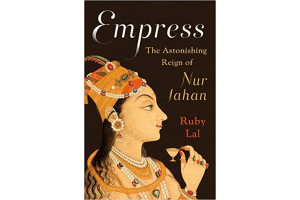Randy Dotinga in The Christian Science Monitor:
 If you grew up in South Asia, the lush 17th-century romance of a captivating young widow and a Moghul emperor is likely as familiar to you as Romeo & Juliet are in the West. They meet, and she wows the ruler of tens of millions of people with her beauty, wit, and fearlessness. Wise and savvy, she becomes his beloved 20th wife and goes on to live an extraordinary life. She writes poetry, designs gardens and buildings, and even saves a village by hunting down and killing four dangerous tigers with six shots. That’s as far as the legend and the history books tend to go. But there’s much more to the story, as historian Ruby Lal reveals in her fascinating new book Empress: The Astonishing Reign of Nur Jahan.
If you grew up in South Asia, the lush 17th-century romance of a captivating young widow and a Moghul emperor is likely as familiar to you as Romeo & Juliet are in the West. They meet, and she wows the ruler of tens of millions of people with her beauty, wit, and fearlessness. Wise and savvy, she becomes his beloved 20th wife and goes on to live an extraordinary life. She writes poetry, designs gardens and buildings, and even saves a village by hunting down and killing four dangerous tigers with six shots. That’s as far as the legend and the history books tend to go. But there’s much more to the story, as historian Ruby Lal reveals in her fascinating new book Empress: The Astonishing Reign of Nur Jahan.
While some historians dismiss the idea that Nur Jahan was anything but a royal consort, Lal contends that she served as co-sovereign with her husband while living in a harem. In a culture of male dominance, Lal writes, “a new kind of power was on display.” “The basic facts,” Lal said in a Monitor interview, “are pretty astounding. To put it plainly, she was the one woman we can count among the great rulers of India.”
Q: What drew you to Nur Jahan, a Shiite Muslim from an immigrant Iranian family who marries a Sunni Muslim who is half-Hindu?
This is a woman who was clearly bold, independent, and very inventive in challenging the norm in quite extraordinary ways. For me as a historian of India, the empress is not an add-on. She is the story of India. Once you know about people like her, you turn your head and see things differently. You see a place of creative, living, dynamic, influential women.
More here.
